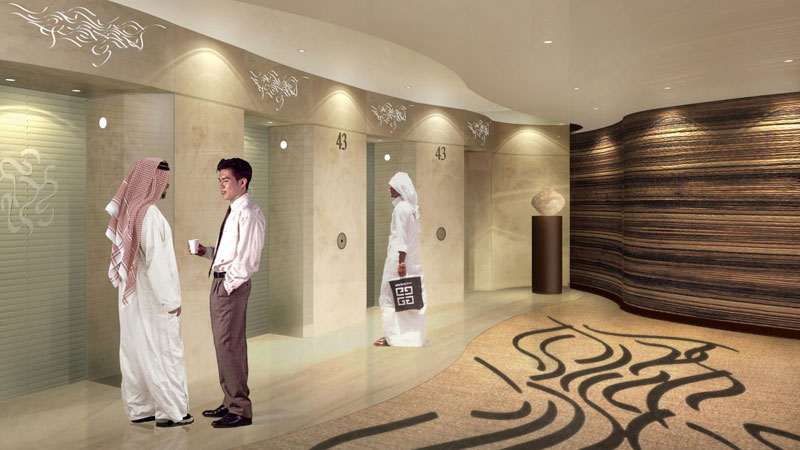Work on Burj Dubai interiors rapidly progresses.
 Other News
Other News Subscribe to newsletter
Subscribe to newsletter
| 6 May 2009 |
Work on the interiors of Burj Dubai, the world’s tallest building developed by Emaar Properties, is progressing alongside the tower’s exterior cladding. Currently over 800 metres high, the tower’s interiors are an aesthetic confluence of the best of the architectural influences from around the world and the region.
Complementing the external architecture of the tower that is inspired by the geometries of the desert flower Hymenocalis and regional patterning systems, the interior design of Burj Dubai was conceptualised and led by award-winning designer Ms Nada Andric of Chicago-based Skidmore, Owings & Merrill LLP (SOM).
While designing, Ms Andric worked towards attaining two main purposes - to recognize and acknowledge the building’s epoch marking height, its structural and architectural rationale and challenges; and to appreciate the location and region’s heritage, history and culture.
Mr Mohamed Alabbar, Chairman, Emaar Properties, said: “Burj Dubai is a once in a lifetime architectural accomplishment and is the Arab world’s tribute to the art and science of modern engineering and design. A global icon that draws on international engineering expertise, Burj Dubai will symbolize the aesthetic unison of many cultures – from Arabia and the rest of the world.”
He added: “The interiors place a special focus on the region’s heritage and geographical location in its design approach and selection of materials. The design emphasizes on the best results in space planning and utilization alongside the finest detailing, to give residents and visitors an unprecedented lifestyle experience.”

A globally acknowledged and award-winning interior designer credited with interior design of several design projects and large-scale architecture, Ms Andric’s design approach was not to take literal, stereotypical translations for the region’s cultural influences but to turn to scholarship to develop the vocabulary inspired by the region’s history cultural understanding of the heritage of the Arabic world and its interpretation into spatial elements, the right selection of materials and a concerted effort to blend the traditional motifs and patterns with modernity.
Apart from glass, stainless steel and polished dark stones, the interiors of Burj Dubai also feature Silver Travertine flooring, Venetian stucco walls, handmade rugs, stone flooring and dark, intricate Brazilian Santos Rosewood to reflect shelter, comfort, and above all, restrained luxury. Surfaces on the upper floors will be advanced in finishes of silver metallic lacquers to provide a sense of brightness and enlightenment. Commissioned local and international fine art pieces will be thoughtfully integrated across the interiors of tower to complete the atmosphere of ultimate refinement.
Ms Andric explained: “Burj Dubai’s interiors are mindful of the building’s prominent international address and its true purpose as home to a number of people, while being inspired by the fascinating local culture and the challenge of enhancing the value of a global landmark. This unique approach is reflected in all aspects from careful planning of all the public areas, the subliminal reference to free flowing Arabic script, colours and materials and the implementation with an aim to showcase global technology and human achievement.”
She added: “For the interiors, the highly edited colour and material palette is inspired by the region’s fine sand and the tradition of pearl harvesting, which are offset by the indigenous dark hues of wood. The layouts for the common areas of the tower have been inspired by cursive Arabic writing as rooms flow elegantly in an intelligent interplay of light and shadow.”
A mixed-use tower featuring the world’s first Armani Hotel Dubai and Armani Residences, alongside corporate suites, residences, retail and leisure facilities, Burj Dubai is at the centre of Downtown Burj Dubai, a 500-acre mega-development by Emaar Properties. Among an array of lifestyle amenities, the tower will have a public observatory deck on level 124.
Described as the new heart of Dubai, Downtown Burj Dubai encompasses The Dubai Mall, one of the world’s largest shopping and entertainment destinations; several hotels; offices and homes. A stellar attraction within the community is The Dubai Fountain, the world’s tallest performing fountain.
Burj Dubai has already achieved the distinction of being the world's tallest structure surpassing the KVLY-TV mast (628.8 metres; 2,063 ft) in North Dakota, USA. The tower is taller than Taipei 101 in Taiwan, which at 508 metres (1,667 ft) has held the tallest-building-in-the-world title since it opened in 2004. Burj Dubai also surpassed the 31-year-old record of CN Tower, which at 553.33 metres (1,815.5 ft) has been the world’s tallest free-standing structure on land since 1976.
Designed by SOM, Burj Dubai is constructed by high-rise experts South Korea’s Samsung Corporation. Turner Construction International is the project and construction manager. The tower employs the latest in wind engineering, structural engineering, structural systems, construction materials and construction methods.




